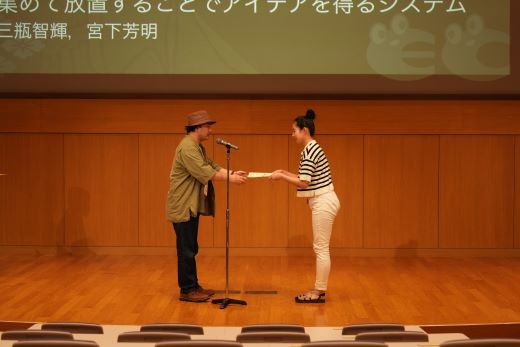[School of Interdisciplinary Mathematical Sciences] KIM Minji, MURAKAMI Shuto and Professor MIYASHITA Homei win the Best Demonstration Award at Entertainment Computing 2023 for their “demonstration of changing the taste of white wine to that of red wine”
Sep. 29, 2023




At Entertainment Computing 2023 (EC2023), held by Special Interest Group on Entertainment Computing of the Information Processing Society of Japan at Tokyo University of Technology from August 30 to September 2, 2023, KIM Minji and MURAKAMI Shuto, third- and fourth-year students and Professor MIYASHITA Homei in the Department of Frontier Media Science gave a podium presentation about their research titled "Reproduction of wine tastes using TTTV3" and won the Best Demonstration Award (an award given to the two most superior demonstrations in the society).
The idea is to reproduce the taste of a different white or red wine by adding a pure substance to a white wine.
On the day of the event, the professional reproducibility assessment results, and taste sensor measurement data was displayed on a poster, as well as a demonstration in which participants were invited to compare white wine, red wine, and reproduced red wine. About 60 people compared and experienced it, and it was well received.
KIM Minji, MURAKAMI Shuto, and Miyashita Homei. Reproduction of wine tastes using TTTV3. Entertainment Computing 2023 Proceedings, Vol. 2023, pp. 298-301, 2023.
Outline: This paper describes a method of mixing a taste solution into a base wine and expressing the taste of the target wine using TTTV3. Based on white wine, it can express the taste of red wine by adding astringency with tannic acid. In addition, it was demonstrated that even when the sour taste of the base is stronger than that of the target and only the sour taste needs to be diluted, the taste can be reproduced by neutralization with sodium bicarbonate, which is alkaline, and masking with sweetening by sucrose.
≪Japanese version≫
The idea is to reproduce the taste of a different white or red wine by adding a pure substance to a white wine.
On the day of the event, the professional reproducibility assessment results, and taste sensor measurement data was displayed on a poster, as well as a demonstration in which participants were invited to compare white wine, red wine, and reproduced red wine. About 60 people compared and experienced it, and it was well received.
KIM Minji, MURAKAMI Shuto, and Miyashita Homei. Reproduction of wine tastes using TTTV3. Entertainment Computing 2023 Proceedings, Vol. 2023, pp. 298-301, 2023.
Outline: This paper describes a method of mixing a taste solution into a base wine and expressing the taste of the target wine using TTTV3. Based on white wine, it can express the taste of red wine by adding astringency with tannic acid. In addition, it was demonstrated that even when the sour taste of the base is stronger than that of the target and only the sour taste needs to be diluted, the taste can be reproduced by neutralization with sodium bicarbonate, which is alkaline, and masking with sweetening by sucrose.
≪Japanese version≫
Related links


